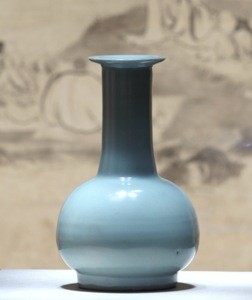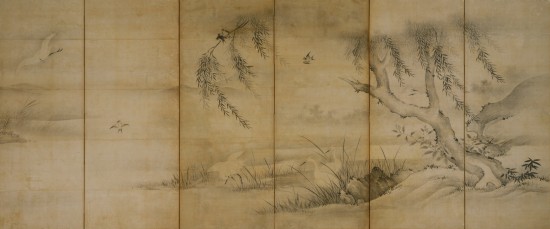
Celadon vase with long neck on globular body (National Treasure), Southern Song dynasty, China
Celadon vase with long neck on globular body exhibits a symmetrical beauty, with its pale blue glaze, smooth surface and soft roundness in perfect harmony. It is thought to be the most exquisite of the blue celadon vases that have come from China. Its transparent, sky-blue color and elegant shape are considered ideal, and it displays a variety of expressions that change with the viewing conditions. We invite you to enjoy the contrasting colors and forms in the selection of ink paintings and contemporary artworks on view.

Birds and flowers (part of paintings used for wallpaper and sliding doors at Nikko-in guest hall in Mi’idera temple), Kano school, pair of six-fold screens, Momoyama – Edo period
Selections from the Hara Rokuro Collection:
Celadon vase with long neck on globular body (National Treasure) and Ink Paintings
August 3 (Friday) – September 9 (Sunday), 2012
Kankai Pavilion (Traditional East Asian Art)
Featured works (selected)
Traditional Art:
【Part I】Scene based on an anecdote by Tao Yuanming (poet of Jin dynasty) (part of paintings used for wallpaper and sliding doors at Nikko-in guest hall in Mi’idera temple), Kano school, four hanging scrolls, Momoyama period/Wild horses and horsemen (part of paintings used for wallpaper and sliding doors at Nikko-in guest hall in Mi’idera temple), Kano school, four hanging scrolls, Momoyama – Edo period/Huangshi-gong and Zhanglian under a pine tree (part of a set of twelve hanging scrolls by painters of the Kano school), Kano Takanobu, hanging scroll, Edo period, and others
【Part II】Celadon vase with long neck on globular body (National Treasure), Southern Song dynasty, 13th century, China/Birds and flowers (part of paintings used for wallpaper and sliding doors at Nikko-in guest hall in Mi’idera temple), Kano school, pair of six-fold screens, Momoyama – Edo period/Dragon and tiger, Kano Tan’yu, pair of hanging scrolls, Edo period/Tiger, Ganku, hanging scroll, Edo period, and others
Contemporary Art: Yves Klein, Blue Sponge, 1960/Toshimitsu ImaÏ, Water, 1977/Hiroshi Sugimoto, Seascapes, 1988-1991/Anish Kapoor, Void, 1992/Noe Aoki, Tateyama, 2007, and others
■EVENTS
Residency Program
Tetsuro Kano, Clear Signs, Vivid Tones
Open Studio: August 6 (Monday) – 11(Saturday) *Works on display: August 12 (Sunday) – September 9 (Sunday)
Venue: Contemporary Gallery B
Talk: On Art and Industrial Waste
August 12 (Sunday) 5:00 pm – 6:30 pm
Sumiyoshi Nakadai x Tetsuro Kano x Kazuko Aono (moderator)
Fee: General 1,500 yen, Hara Museum Members 500 yen (includes museum admission and a drink)
Limited to 70 seats
*The talk will be given in Japanese only.
Workshop: Nakadai Ikaho Factory: Mono Factory x Hara Museum ARC
August 11(Saturday) – 15 (Wednesday) 10:30am – 4:00pm (Last entry at 3:30 pm)
In this workshop, participants process (= make and play) and disassemble (break and learn) industrial waste materials in a variety of ways. Participants will have open access to the materials shop (= discovering many kinds of things).
Workshop fee: from 1,050 yen (separate from museum admission) *Please note that only a limited supply of materials will available for disassembly.
Workshop: Let´s Make Art Fans
August 4 (Saturday), 5 (Sunday), 18 (Saturday), 19 (Sunday); Three sessions/day at 10:30 am, 1:00 pm and 3:00 pm
Workshop fee: 500 yen (separate from museum admission)
Participants will make a washi origami, make a pretty pattern on it with color dyes, and turn it into a finished fan.
Place: Hara Museum ARC (2855-1, Kanai, Shibukawa-shi, Gunma 377-0027) Tel: 0279-24-6585
Organized by: Hara Museum of Contemporary Art
http://www.haramuseum.or.jp (official website) http://mobile.haramuseum.or.jp (mobile site)
https://www.art-it.asia/en/u/HaraMuseum_e (blog) http://twitter.com/HaraMuseumARC (Twitter)
Hours: 9:30 am – 4:30 pm *Last entry 30 minutes before closing
Closed: Thursdays (except during the month of August) *Closed temporarily in the event of severe weather.
Admission: General (over 12) 1,000 yen; Children (over 3) 500 yen; 10% discount for a group of 20 or more.
**Children must be accompanied by an adult ***Combination ticket for Hara Museum ARC and Ikaho Green Bokujo ranch: General 1,800 yen; Children 900 yen
Hara Museum ARC is now participating in MuPon (museum discount ticket system using iPhone application).
http://www.tokyoartbeat.com/apps/mupon
Directions: By train: Take the Joetsu Shinkansen to Takasaki, change to the Joestu Line, and disembark at Shibukawa. From Shibukawa, ARC is 10 minutes away by taxi or 15 minutes by bus (take the Ikaho Onsen bus to ″Green Bokujo Mae″). By car: 8 kilometers (about 15 minutes) from the Kan-etsu Expressway Shibukawa Ikaho Interchange (in the direction of Ikaho Onsen).
